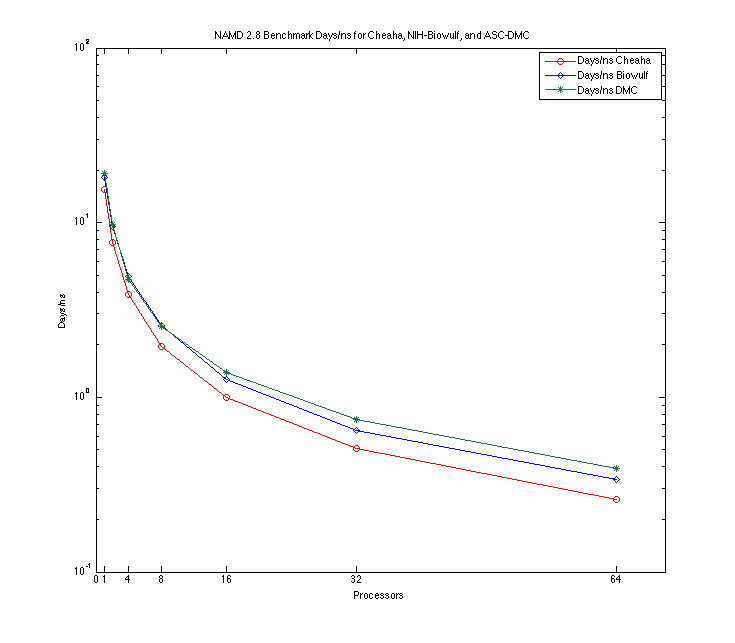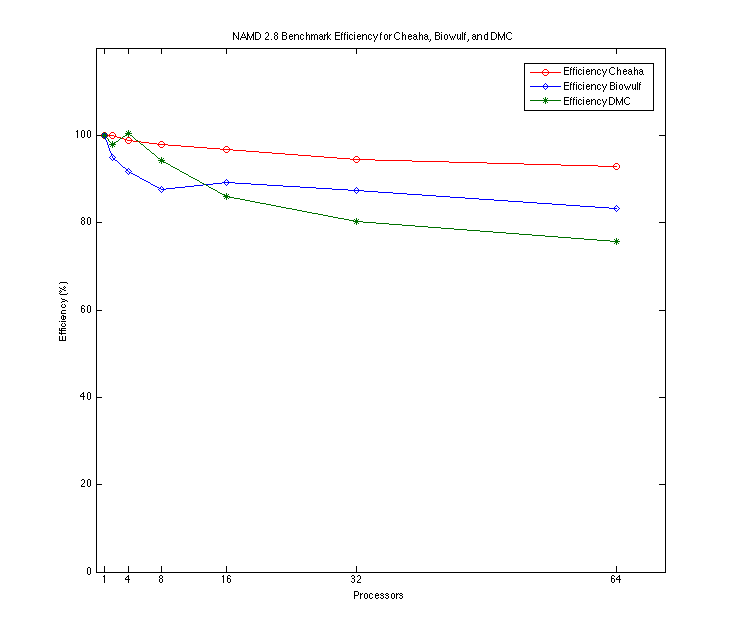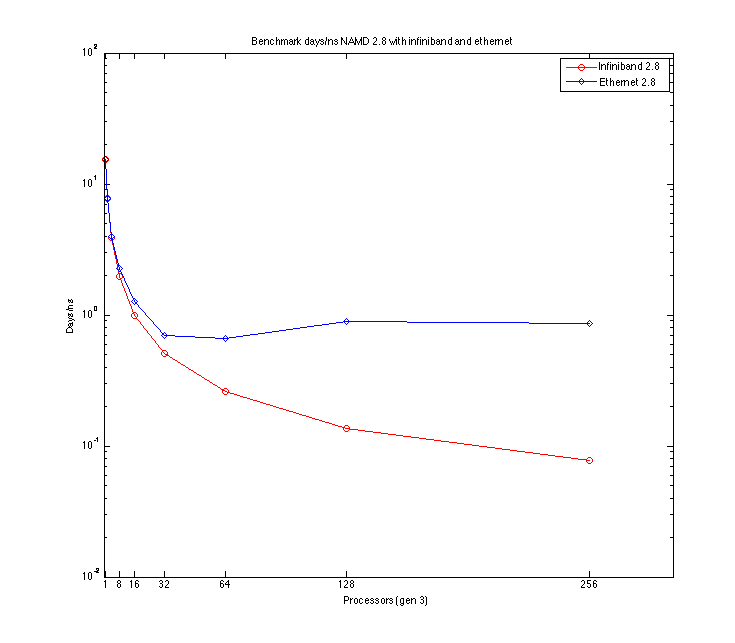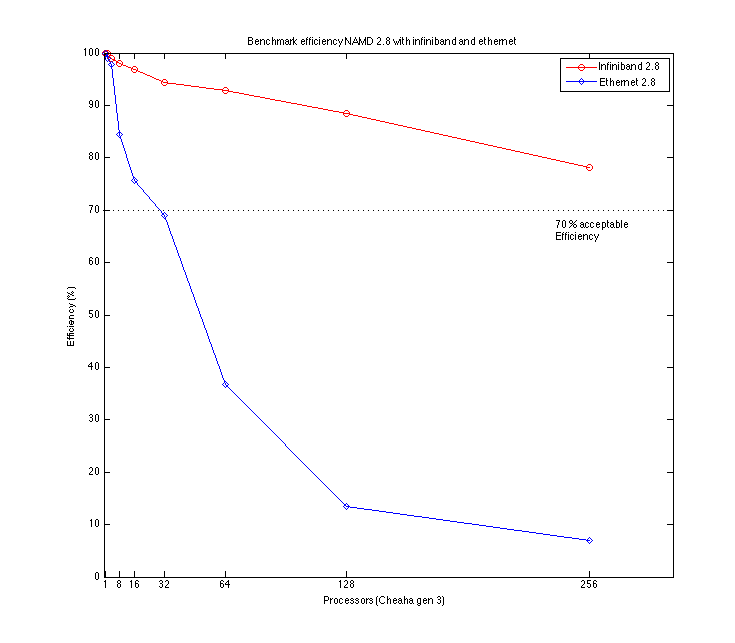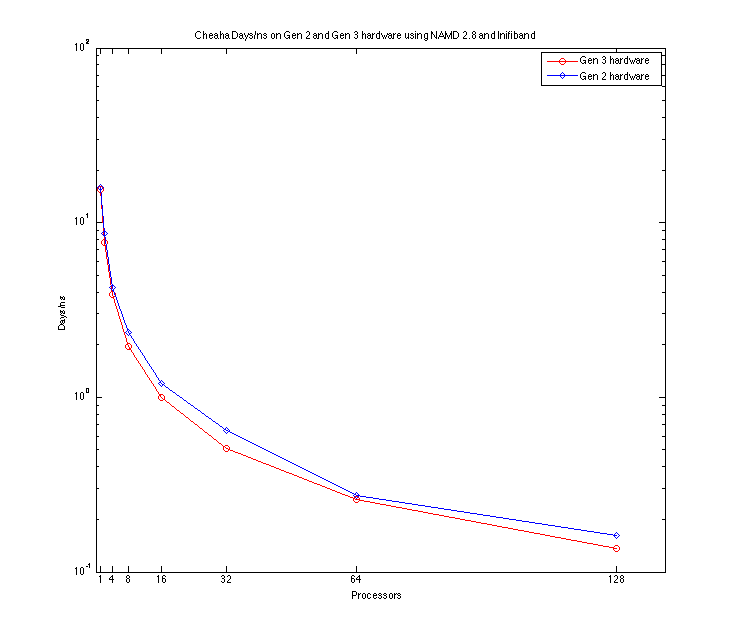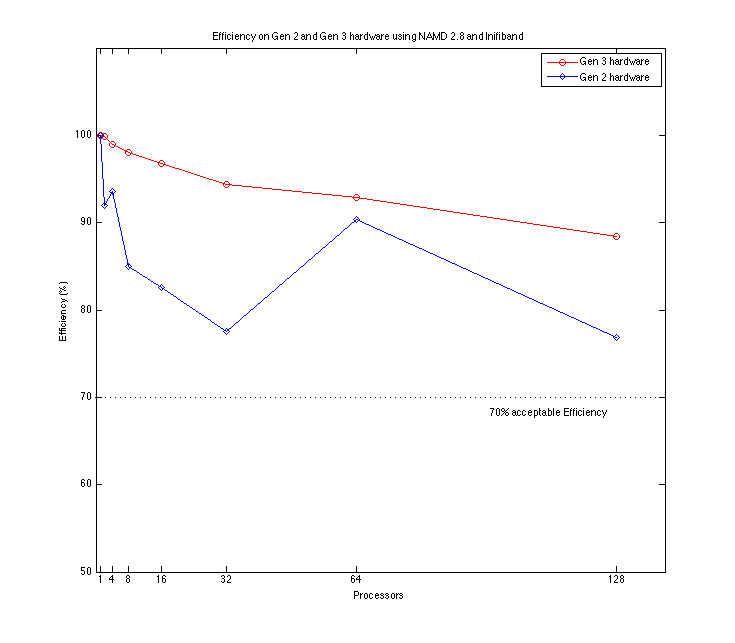Talk:NAMD Benchmarks: Difference between revisions
No edit summary |
(added category NAMD) |
||
| (33 intermediate revisions by the same user not shown) | |||
| Line 1: | Line 1: | ||
The efficiency of a parallel system describes the fraction of the time that is being used by the processors for a given computation. It is defined as | |||
<pre> | |||
Scaling | Execution time using one processor ts | ||
E(n)= -------------------------------------- = ---- | |||
N * Execution time using N processors N tn | |||
</pre> | |||
In general, parallel jobs should scale to at least 70% efficiency. The ASC's DMC recommends a scaling efficiency of 75% or greater. For NAMD the efficiency of a parallel job can be calculated as follows (where N is processors committed to the job): | |||
<pre> | |||
days/ns where N = 1 | |||
--------------------- * 100 = Efficiency | |||
N * days/ns | |||
</pre> | |||
Information on NAMD performance Scaling is available at: http://www.ks.uiuc.edu/Research/namd/wiki/?NamdPerformanceTuning | |||
Benchmark used for performance evaluation on the [[Cheaha]], [http://biowulf.nih.gov Biowulf], and [http://www.asc.edu/supercomputing/index.shtml DMC] is Apoa1 from the NAMD suite and is available at: http://www.ks.uiuc.edu/Research/namd/utilities/ | |||
The parameters for the benchmark used throughout are: 500 steps, 92K atoms, 12A cutoff + PME every 4 steps. | |||
== Sample Benchmark using NAMD == | == Sample Benchmark using NAMD == | ||
===Sample Benchmark comparing Days/ns for Cheaha, Biowulf, and DMC using InfiniBand=== | ===Sample Benchmark comparing Days/ns for Cheaha, Biowulf, and DMC using InfiniBand=== | ||
{| border="1" align="center" style="text-align:center;" | {| border="1" align="center" cellpadding="10" style="text-align:center;" | ||
|+ Days/ns (efficiency) on Cheaha, Biowulf, and DMC | |+ Days/ns (efficiency) on Cheaha, Biowulf, and DMC | ||
!Processors | !Processors | ||
! | ! Cheaha | ||
! | ! Biowulf | ||
! | ! DMC <ref group="note" >No hardware control was possible for the ASC's DMC and as such it is possible that different runs might have run on different hardware. *Efficiency on DMC using 4 processors is above 100%. This could be probably because of an older generation processor being used to run the job serially i.e. using 1 processor, thus setting a lower baseline to begin with causing the efficiency to go up as better processors are available for the parallel jobs.</ref> | ||
|- | |- | ||
|1 | |1 | ||
|15.4054 | |15.4054 (100%) | ||
|18.0535 | |18.0535 (100%) | ||
|19.1000 | |19.1000 (100%) | ||
|- | |- | ||
|2 | |2 | ||
|7.7119 | |7.7119 (99.87%) | ||
|9.5163 | |9.5163 (94.86%) | ||
|9.7600 | |9.7600 (97.84%) | ||
|- | |- | ||
|4 | |4 | ||
|3.8933 | |3.8933 (98.92%) | ||
|4.9222 | |4.9222 (91.69%) | ||
|4.7570 | |4.7570 (100.3%)* | ||
|- | |- | ||
|8 | |8 | ||
|1.9653 | |1.9653 (97.98%) | ||
|2.5763 | |2.5763 (87.59%) | ||
|2.5360 | |2.5360 (94.14%) | ||
|- | |- | ||
|16 | |16 | ||
|0.9950 | |0.9950 (96.76%) | ||
|1.2658 | |1.2658 (89.14%) | ||
|1.3870 | |1.3870 (86.06%) | ||
|- | |- | ||
|32 | |32 | ||
|0.5101 | |0.5101 (94.37%) | ||
|0.6463 | |0.6463 (87.29%) | ||
|0.7438 | |0.7438 (80.24%) | ||
|- | |- | ||
|64 | |64 | ||
|0.2592 | |0.2592 (92.83%) | ||
|0.3390 | |0.3390 (83.22%) | ||
|0.3938 | |0.3938 (75.78%) | ||
|- | |- | ||
|128 | |128 | ||
|0.1360 | |0.1360 (88.45%) | ||
|NA | |NA | ||
|NA | |NA | ||
|- | |- | ||
|256 | |256 | ||
|0.0770 | |0.0770 (78.09%) | ||
|NA | |||
|NA | |||
|- | |||
|512 | |||
|0.0439 (68.49%) | |||
|NA | |NA | ||
|NA | |NA | ||
|} | |} | ||
[[File:NAMD_benchmark_img1_Days_cheaha_dmc_biowulf.png]] | [[File:NAMD_benchmark_img1_Days_cheaha_dmc_biowulf.png|center]] | ||
[[File:NAMD_benchmark_img2_Efficiency_cheaha_dmc_biowulf.png|center]] | |||
===Bench mark notes=== | |||
The above benchmarks were run using NAMD 2.8b1 and the [http://www.ks.uiuc.edu/Research/namd/utilities/ Apoa1 benchmark suite] from NAMD. | |||
On Cheaha, only the third generation hardware was used for the above benchmarks. More information about the hardware used on [[Cheaha]] is available [[Cheaha#Hardware |here]]. | |||
The data for the NIH-Biowulf benchmarks is available at: http://biowulf.nih.gov/apps/namd/namd_bench.html. The Biowulf hardware used for comparison in the e2800 with Infiniband. | |||
= | ;ASC-DMC | ||
<references group="note"/> | |||
== Comparison of Ethernet and IB == | == Comparison of Ethernet and IB == | ||
{| border="1" align="center" cellpadding="10" style="text-align:center;" | |||
|+ Ethernet vs Infiniband interconnect on Cheaha Gen 3 hardware | |||
!Processors | |||
! Infiniband | |||
! Ethernet | |||
|- | |||
|1 | |||
|15.4054 (100%) | |||
|15.4040 (100%) | |||
|- | |||
|2 | |||
|7.7119 (99.87%) | |||
|7.7800 (98.99%) | |||
|- | |||
|4 | |||
|3.8933 (98.92%) | |||
|3.9405 (97.72%) | |||
|- | |||
|8 | |||
|1.9653 (97.98%) | |||
|2.2816 (84.39%) | |||
|- | |||
|16 | |||
|0.9950 (96.76%) | |||
|1.2714 (75.74%) | |||
|- | |||
|32 | |||
|0.5101 (94.37%) | |||
|0.6973 (69.03%) | |||
|- | |||
|64 | |||
|0.2592 (92.83%) | |||
|0.6562 (36.67%) | |||
|- | |||
|128 | |||
|0.1360 (88.45%) | |||
|0.8950 (13.44%) | |||
|- | |||
|256 | |||
|0.0770 (78.09%) | |||
|0.8632 (6.97%) | |||
|- | |||
|512 | |||
|0.0439 (68.49%) | |||
|NA | |||
|} | |||
[[File:NAMD_benchmark_img3_Ib_eth_days_ns_2.8.png|center]] | |||
[[File:NAMD_benchmark_img4_Ib_eth_efficiency_2.8.png|center]] | |||
== Comparison on different Generations of Cheaha hardware on NAMD with Infinband == | |||
{| border="1" align="center" cellpadding="10" style="text-align:center;" | |||
|+ Cheaha Gen 2 and Gen 3 hardware using NAMD 2.8 and Inifiband | |||
!Processors | |||
! Generation 3 | |||
! Generation 2 | |||
|- | |||
|1 | |||
|15.4054 (100%) | |||
|15.9300 (100%) | |||
|- | |||
|2 | |||
|7.7119 (99.87%) | |||
|8.6620 (91.98%) | |||
|- | |||
|4 | |||
|3.8933 (98.92%) | |||
|4.2560 (93.59%) | |||
|- | |||
|8 | |||
|1.9653 (97.98%) | |||
|2.3450 (84.93%) | |||
|- | |||
|16 | |||
|0.9950 (96.76%) | |||
|1.2060 (82.56%) | |||
|- | |||
|32 | |||
|0.5101 (94.37%) | |||
|0.6420 (77.57%) | |||
|- | |||
|64 | |||
|0.2592 (92.83%) | |||
|0.2750 (90.38%) | |||
|- | |||
|128 | |||
|0.1360 (88.45%) | |||
|0.1620 (76.81%) | |||
|- | |||
|256 | |||
|0.0770 (78.09%) | |||
|NA | |||
|- | |||
|512 | |||
|0.0439 (68.49%) | |||
|NA | |||
|} | |||
[[File:NAMD_benchmark_img5_Days_gen2_gen3_infiniband.png|center]] | |||
[[File:NAMD_benchmark_img6_Efficiency_gen2_gen3_ib.png|center]] | |||
== | ===Hardware Notes=== | ||
Generation 3 hardware contains 576 cores. 2.66 GHz Intel Xeon Hex-core (48-2x6 core) | |||
Generation 2 hardware contains 192 cores. 3.06 GHz Intel Xeon Quad-core (24-2x4 core) | |||
More information about the hardware used on [[Cheaha]] is available [[Cheaha#Hardware |here]]. | |||
== Actual job benchmarks (Segrest job) == | == Actual job benchmarks (Segrest job) == | ||
Actual NAMD job courtesy of Center for Computational and Structural Biology. | |||
STRUCTURE SUMMARY: | |||
Job parameters: 100,000 steps, 246K atoms, 12A cutoff + PME every 4 steps | |||
245956 ATOMS | |||
174192 BONDS | |||
130742 ANGLES | |||
84410 DIHEDRALS | |||
1622 IMPROPERS | |||
0 CROSSTERMS | |||
0 EXCLUSIONS | |||
232802 RIGID BONDS | |||
505063 DEGREES OF FREEDOM | |||
84698 HYDROGEN GROUPS | |||
4 ATOMS IN LARGEST HYDROGEN GROUP | |||
84698 MIGRATION GROUPS | |||
4 ATOMS IN LARGEST MIGRATION GROUP | |||
TOTAL MASS = 1.48179e+06 amu | |||
TOTAL CHARGE = 2.7746e-05 e | |||
MASS DENSITY = 1.01378 g/cm^3 | |||
ATOM DENSITY = 0.101334 atoms/A^3 | |||
=== Speedup (Actual Wall times, days/ns, efficiency)=== | |||
{| border="1" align="center" cellpadding="10" style="text-align:center;" | |||
|+ Actual NAMD CSB job on Cheaha Gen 3 hardware | |||
!Processors | |||
! Wall Clock | |||
! Days/ns | |||
! Speedup | |||
|- | |||
|1 | |||
|357278 (99hrs 14mins) | |||
|20.4950 (100%) | |||
|1 | |||
|- | |||
|8 | |||
|45784 (12hrs 42mins) | |||
|2.6237 (97.64%) | |||
|7.80 | |||
|- | |||
|16 | |||
|23380 (6hrs 29mins) | |||
|1.33205 (96.16%) | |||
|15.28 | |||
|- | |||
|32 | |||
|11871 (3hrs 17mins) | |||
|0.6809 (94.04%) | |||
|30.09 | |||
|- | |||
|64 | |||
|6242 (1hr 43mins) | |||
|0.3626 (88.30%) | |||
|57.23 | |||
|- | |||
|128 | |||
|3386 (56mins 26secs) | |||
|0.1940 (82.51%) | |||
|105.51 | |||
|- | |||
|256 | |||
|1814 (30mins 14secs) | |||
|0.0982 (81.51%) | |||
|196.96 | |||
|- | |||
|512 | |||
|1129 (18mins 49secs) | |||
|0.0578 (69.21%) | |||
|316.46 | |||
|} | |||
[[File:NAMD_benchmark_image_6_Effciency_combined_AM.png|center]] | |||
=== Actual job comparison to IBM BG/L === | |||
NAMD Comparison data to UAB IBM BlueGene/L. | |||
Job parameters: 100,000 steps, 246K atoms, 12A cutoff + PME every 4 steps | |||
{| border="1" align="center" cellpadding="10" style="text-align:center;" | |||
|+ NAMD Comparison to IBM BG/L | |||
! System | |||
! CPU count | |||
! Atoms | |||
! Days/ns | |||
|- | |||
|UAB BlueGene/L | |||
|256 | |||
|246K | |||
|0.80 | |||
|- | |||
|Cheaha Gen3 | |||
|32 | |||
|246K | |||
|0.6809 | |||
|- | |||
|Cheaha Gen3 | |||
|256 | |||
|246K | |||
|0.0982 | |||
|- | |||
|Cheaha Gen3 | |||
|512 | |||
|246K | |||
|0.0578 | |||
|} | |||
The Cheaha outperforms the BG/L using only 32 cores on the gen 3 hardware. At equal processor count the Cheaha is roughly 8 times faster than the BG/L. | |||
== Perform Your Own Benchmarks == | == Perform Your Own Benchmarks == | ||
[[Category:NAMD]] | |||
Latest revision as of 17:19, 9 June 2011
The efficiency of a parallel system describes the fraction of the time that is being used by the processors for a given computation. It is defined as
Execution time using one processor ts
E(n)= -------------------------------------- = ----
N * Execution time using N processors N tn
In general, parallel jobs should scale to at least 70% efficiency. The ASC's DMC recommends a scaling efficiency of 75% or greater. For NAMD the efficiency of a parallel job can be calculated as follows (where N is processors committed to the job):
days/ns where N = 1
--------------------- * 100 = Efficiency
N * days/ns
Information on NAMD performance Scaling is available at: http://www.ks.uiuc.edu/Research/namd/wiki/?NamdPerformanceTuning
Benchmark used for performance evaluation on the Cheaha, Biowulf, and DMC is Apoa1 from the NAMD suite and is available at: http://www.ks.uiuc.edu/Research/namd/utilities/
The parameters for the benchmark used throughout are: 500 steps, 92K atoms, 12A cutoff + PME every 4 steps.
Sample Benchmark using NAMD
Sample Benchmark comparing Days/ns for Cheaha, Biowulf, and DMC using InfiniBand
| Processors | Cheaha | Biowulf | DMC <ref group="note" >No hardware control was possible for the ASC's DMC and as such it is possible that different runs might have run on different hardware. *Efficiency on DMC using 4 processors is above 100%. This could be probably because of an older generation processor being used to run the job serially i.e. using 1 processor, thus setting a lower baseline to begin with causing the efficiency to go up as better processors are available for the parallel jobs.</ref> |
|---|---|---|---|
| 1 | 15.4054 (100%) | 18.0535 (100%) | 19.1000 (100%) |
| 2 | 7.7119 (99.87%) | 9.5163 (94.86%) | 9.7600 (97.84%) |
| 4 | 3.8933 (98.92%) | 4.9222 (91.69%) | 4.7570 (100.3%)* |
| 8 | 1.9653 (97.98%) | 2.5763 (87.59%) | 2.5360 (94.14%) |
| 16 | 0.9950 (96.76%) | 1.2658 (89.14%) | 1.3870 (86.06%) |
| 32 | 0.5101 (94.37%) | 0.6463 (87.29%) | 0.7438 (80.24%) |
| 64 | 0.2592 (92.83%) | 0.3390 (83.22%) | 0.3938 (75.78%) |
| 128 | 0.1360 (88.45%) | NA | NA |
| 256 | 0.0770 (78.09%) | NA | NA |
| 512 | 0.0439 (68.49%) | NA | NA |
Bench mark notes
The above benchmarks were run using NAMD 2.8b1 and the Apoa1 benchmark suite from NAMD.
On Cheaha, only the third generation hardware was used for the above benchmarks. More information about the hardware used on Cheaha is available here.
The data for the NIH-Biowulf benchmarks is available at: http://biowulf.nih.gov/apps/namd/namd_bench.html. The Biowulf hardware used for comparison in the e2800 with Infiniband.
- ASC-DMC
<references group="note"/>
Comparison of Ethernet and IB
| Processors | Infiniband | Ethernet |
|---|---|---|
| 1 | 15.4054 (100%) | 15.4040 (100%) |
| 2 | 7.7119 (99.87%) | 7.7800 (98.99%) |
| 4 | 3.8933 (98.92%) | 3.9405 (97.72%) |
| 8 | 1.9653 (97.98%) | 2.2816 (84.39%) |
| 16 | 0.9950 (96.76%) | 1.2714 (75.74%) |
| 32 | 0.5101 (94.37%) | 0.6973 (69.03%) |
| 64 | 0.2592 (92.83%) | 0.6562 (36.67%) |
| 128 | 0.1360 (88.45%) | 0.8950 (13.44%) |
| 256 | 0.0770 (78.09%) | 0.8632 (6.97%) |
| 512 | 0.0439 (68.49%) | NA |
Comparison on different Generations of Cheaha hardware on NAMD with Infinband
| Processors | Generation 3 | Generation 2 |
|---|---|---|
| 1 | 15.4054 (100%) | 15.9300 (100%) |
| 2 | 7.7119 (99.87%) | 8.6620 (91.98%) |
| 4 | 3.8933 (98.92%) | 4.2560 (93.59%) |
| 8 | 1.9653 (97.98%) | 2.3450 (84.93%) |
| 16 | 0.9950 (96.76%) | 1.2060 (82.56%) |
| 32 | 0.5101 (94.37%) | 0.6420 (77.57%) |
| 64 | 0.2592 (92.83%) | 0.2750 (90.38%) |
| 128 | 0.1360 (88.45%) | 0.1620 (76.81%) |
| 256 | 0.0770 (78.09%) | NA |
| 512 | 0.0439 (68.49%) | NA |
Hardware Notes
Generation 3 hardware contains 576 cores. 2.66 GHz Intel Xeon Hex-core (48-2x6 core) Generation 2 hardware contains 192 cores. 3.06 GHz Intel Xeon Quad-core (24-2x4 core) More information about the hardware used on Cheaha is available here.
Actual job benchmarks (Segrest job)
Actual NAMD job courtesy of Center for Computational and Structural Biology.
STRUCTURE SUMMARY:
Job parameters: 100,000 steps, 246K atoms, 12A cutoff + PME every 4 steps 245956 ATOMS 174192 BONDS 130742 ANGLES 84410 DIHEDRALS 1622 IMPROPERS 0 CROSSTERMS 0 EXCLUSIONS 232802 RIGID BONDS 505063 DEGREES OF FREEDOM 84698 HYDROGEN GROUPS 4 ATOMS IN LARGEST HYDROGEN GROUP 84698 MIGRATION GROUPS 4 ATOMS IN LARGEST MIGRATION GROUP TOTAL MASS = 1.48179e+06 amu TOTAL CHARGE = 2.7746e-05 e MASS DENSITY = 1.01378 g/cm^3 ATOM DENSITY = 0.101334 atoms/A^3
Speedup (Actual Wall times, days/ns, efficiency)
| Processors | Wall Clock | Days/ns | Speedup |
|---|---|---|---|
| 1 | 357278 (99hrs 14mins) | 20.4950 (100%) | 1 |
| 8 | 45784 (12hrs 42mins) | 2.6237 (97.64%) | 7.80 |
| 16 | 23380 (6hrs 29mins) | 1.33205 (96.16%) | 15.28 |
| 32 | 11871 (3hrs 17mins) | 0.6809 (94.04%) | 30.09 |
| 64 | 6242 (1hr 43mins) | 0.3626 (88.30%) | 57.23 |
| 128 | 3386 (56mins 26secs) | 0.1940 (82.51%) | 105.51 |
| 256 | 1814 (30mins 14secs) | 0.0982 (81.51%) | 196.96 |
| 512 | 1129 (18mins 49secs) | 0.0578 (69.21%) | 316.46 |
Actual job comparison to IBM BG/L
NAMD Comparison data to UAB IBM BlueGene/L.
Job parameters: 100,000 steps, 246K atoms, 12A cutoff + PME every 4 steps
| System | CPU count | Atoms | Days/ns |
|---|---|---|---|
| UAB BlueGene/L | 256 | 246K | 0.80 |
| Cheaha Gen3 | 32 | 246K | 0.6809 |
| Cheaha Gen3 | 256 | 246K | 0.0982 |
| Cheaha Gen3 | 512 | 246K | 0.0578 |
The Cheaha outperforms the BG/L using only 32 cores on the gen 3 hardware. At equal processor count the Cheaha is roughly 8 times faster than the BG/L.
